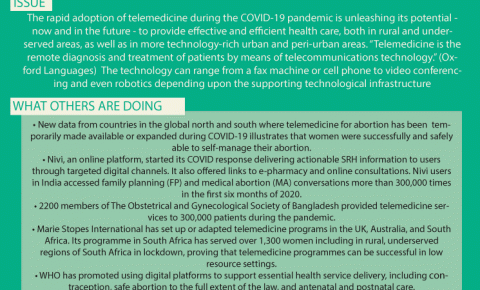Telemedicine: unleashing its potential
The issue
Telemedicine is described as "the remote diagnosis and treatment of patients by means of telecommunications technology.” The rapid adoption of such technology during the COVID-19 pandemic is unleashing its potential – now and in the future – to provide effective and efficient healthcare, both in rural, and underserved areas, as well as in more technology-rich urban and peri-urban areas. The technology can range from a fax machine or cell phone to video conferencing and even robotics depending upon the supporting technological infrastructure.
What others are doing
- New data from countries in the global north and south where telemedicine for abortion has been temporarily made available or expanded during COVID-19 illustrates that women were successfully and safely able to self-manage their abortion.
- Nivi, an online platform, started its COVID-19 response delivering actionable sexual and reproductive health (SRH) information to users through targeted digital channels. It also offered links to e-pharmacy and online consultations. Nivi users in India accessed family planning and medical abortion conversations more than 300,000 times in the first six months of 2020.
- 2,200 members of The Obstetrical and Gynecological Society of Bangladesh provided telemedicine services to 300,000 patients during the pandemic.
- Marie Stopes International has set up or adapted telemedicine programmen the UK, Australia and South Africa. Its programme in South Africa has served over 1,300 women including in rural, underserved regions of South Africa in lockdown, proving that telemedicine programmes can be successful in low-resource settings.
- The World Health Organisation has promoted using digital platforms to support essential health service delivery, including contraception, safe abortion, and antenatal and postnatal care.
What you can do
- Become familiar with the evidence and what others are doing: FIGO has taken a strong, positive stance on the use of telemedicine for medical abortion and self-care methods of contraception.
- Encourage your society to advocate to its government to upgrade the technological infrastructure and to make temporary regulatory changes, which were lowered during the COVID-19 epidemic, to be permanent.
- Even if your service area has low bandwidth for video calls, consider increasing the use of screening and patient follow-up via mobile.
- Help your patients overcome their fear of telemedicine through promotion of self-management in their healthcare.
- Share your experiences of family planning and abortion during the pandemic with us, so we can share them with our membership. Please also share lessons from advising governments to ensure that SRH and maternal health services are on the Essential Services List in your country.
Telemedicine: unleashing its potential during the pandemic
File
